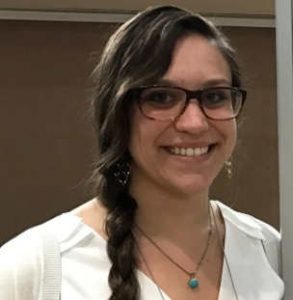
In profile: Kristy Zera
I’m Kristy Zera, a postdoctoral fellow working in the lab of Marion Buckwalter at the Stanford University School of Medicine, in the department of Neurology.
 I did my undergraduate work at Bates College in Lewiston, Maine, and graduated in 2012. Then, I moved to Athens, Georgia, where I obtained a PhD in Pharmaceutical and Biomedical Sciences from the University of Georgia in 2017.
I did my undergraduate work at Bates College in Lewiston, Maine, and graduated in 2012. Then, I moved to Athens, Georgia, where I obtained a PhD in Pharmaceutical and Biomedical Sciences from the University of Georgia in 2017.
Can you briefly describe the research that you do?
The primary focus of my research is understanding how chronic inflammation in the brain after stroke contributes to later cognitive decline. In particular, I’m interested in how endothelial cells mediate the immune response, and contribute to immune cell trafficking into the brain.
As part of this research, I do a lot of immunohistochemistry of mouse brain tissue to look at different immune cell markers, and a lot of mouse behavioural assays to test how well they learn and can remember different objects.
I’ve also recently started collecting samples for single cell RNA sequencing to understand how different cell types respond to stroke.
What is your role in the Stroke-IMPaCT Network?
I am leading the efforts in the Buckwalter lab to collect pre-clinical data on post-stroke cognitive impairment as part of our multi-lab study.
I’ve also been working with members of the Moro, Meisel and Doyle labs to develop a protocol that we can all use to test post-stroke cognitive impairments in mice. One of the benefits of this network is that we can repeat each other’s experiments, and compare our results to see how well they replicate.
This means we can perform experiments similar to clinical trials in people, where drugs are dosed following the same protocols, and then we can see if/how the immune response is different in different labs, and how this changes cognitive outcomes. If we can repeat our findings in multiple labs, we think it’s more likely that these findings will be able to translate into successful human therapies.
What are you enjoying most about being part of this network?
One of the great strengths of this network is the focus on supporting early career investigators, and the efforts being made to foster collaborations between different labs.
For example, we have monthly data presentations by trainees and small funding opportunities meant to support multi-lab collaborative experiments. As a postdoc, these are amazing networking opportunities.
We are working with many of the labs around the world who are all interested in understanding how chronic immune changes after Stroke-IMPaCT cognition. I’ve presented data at one of our monthly meetings to top scientists in the field, and they have given me feedback and suggestions about my experiments.
We also had active discussions about data, and how our work could supplement each other. For example, I’ve discussed the Barnes maze with various members of the Moro lab, which has helped me improve my protocol, and get cleaner data with less variability.
These open discussions of data and protocols have improved my research, and helped me be more efficient with my experiments. Additionally, the personal connections that come from these discussions will be invaluable to me as I move forward in my career.
The quarterly small grants support collaborations between labs and multidisciplinary experiments that might not happen otherwise. Although I haven’t applied for one yet, I’m hoping our next in-person meeting will foster even more discussions about potential collaborations, and give me some new ideas.
What else?
In my free time, I enjoy hiking with my dog, swimming, and exploring the Bay Area.
Contacting me
I’m happy to answer questions about what it’s like working in the Buckwalter lab, and being a part of this international, multi-lab collaborative network. I can be reached at kzera@stanford.edu.






0 Comments